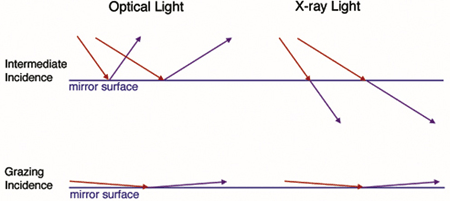A telescope, at its heart, is a device to collect light and deliver that light to a detector, no matter what type of light it is designed to observe. In order to capture and focus X-rays, “grazing incidence” optics must be used. X-rays are so energetic (and have such a small wavelength) that they tend to pass through most matter. Mirrors are no different. Most of the X-rays in a beam shot directly at a mirror would simply pass right through. Traditional designs of telescopes, then, just don't work for X-ray astronomy.
However, if an X-ray encounters a mirror at a “grazing incidence”, i.e. if it just glances the surface of the mirror, then it will bounce, behaving just as an optical photon would.

X-ray telescope design
-
What do X-ray telescopes look like?